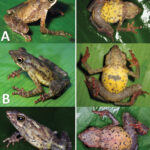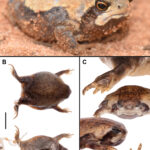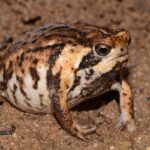Atelopus guitarraensis: The Enigmatic Harlequin Frog of Colombia’s Cloud Forests#
Nestled among mist-shrouded peaks and lush forests of Colombia’s Northern Andes, a striking amphibian with vibrant colors and elusive habits gracefully persists in its delicate ecological dance. Meet Atelopus guitarraensis, commonly known as the Guitarra Harlequin Frog—a tiny yet extraordinary amphibian whose name encapsulates its entire identity. Deriving its evocative moniker from the Sierra Nevada de Santa Marta near Río Guitarra, this brightly patterned treasure of the forest floor is not just visually captivating, but critically important as an indicator species reflecting the environmental health and balance in its habitat.
Characterized by intricate patterns and bold coloration, the Guitarra Harlequin Frog provides more than just aesthetic wonder; it serves as a striking symbol of biodiversity and fragility. Yet beyond its charismatic appearance lies an urgent conservation story. The species—like many of its harlequin frog relatives—faces severe threats from habitat degradation, climate change, diseases, and pollution.
Join us in a journey deep into the misty and biodiverse foothills of the Sierra Nevada de Santa Marta as we uncover the fascinating life, ecological role, and critical conservation situation of Atelopus guitarraensis, Colombia’s enigmatic harlequin frog.
Taxonomy and Classification#
Atelopus guitarraensis belongs to the family Bufonidae, a diverse lineage within the order Anura—the frogs and toads. Often informally termed “harlequin frogs,” members of the Atelopus genus share signature bright colors and diverse patterning, characteristics thought to serve both camouflage and predator warning through indication of toxicity. Harlequin frogs are traditionally known for their dynamic patterns, ranging from vivid hues and sharp contrasts to subtler blends, all adaptations that have evolved in response to distinct environmental pressures.
Described formally by Osorno-Muñoz, Ardila-Robayo, and Ruíz-Carranza in 2001, Atelopus guitarraensis is relatively recently known to science. Nevertheless, it instantly captured attention due to its striking appearance, ecological clarity, and precarious conservation status. The species is closely related to other threatened Colombian endemics, notably Atelopus nahumae, their intertwined evolutionary histories underscoring the endemic richness and vulnerability of Colombian amphibian fauna.
Natural Habitat#
A Mountain Paradise—Sierra Nevada de Santa Marta#
The only known home of Atelopus guitarraensis is embedded within the misty montane forests near the Sierra Nevada de Santa Marta, a standout biodiversity hotspot renowned for its isolated ecosystems and unique endemism. Shrouded in a perpetual veil of mist, these montane forests create an environment of continual moisture, essential to amphibian survival. Rising breathtakingly from Caribbean lowlands to high-altitude páramos, this unique region brims with biological abundance due to varying altitudes, temperature gradients, and microhabitats.
Within this mosaic of ecosystems, the Guitarra Harlequin Frog prefers mid-elevation cloud forests around 1,800-2,400 meters above sea level. Here, crystalline streams carve gently through moss-covered stones and dense vegetation, creating ideal habitats characterized by reliable moisture, shaded microclimates, and a rich diversity of aquatic and terrestrial organisms. This specialized setting houses not only incredible numbers of amphibians but also rare orchids, insects, birds, and mammals—a symphony of biodiversity supported by these interlinked habitats.
The intricate streamside vegetation and thick leaf-litter layer provide critical hunting grounds, shelter, breeding sites, and protection from predators. Moisture retention, temperature stability, and abundance of prey make these cloud forests an irreplaceable refuge for the fragile and temperature-sensitive skin of amphibians—and a fitting home for this dazzling species.
Physical Characteristics#
At first glance, one can’t help but marvel at the striking beauty of the Guitarra Harlequin Frog. Despite its diminutive size, averaging only about 25-35 millimeters long, it commands attention through dramatic coloration and patterning that epitomize nature’s artistic mastery. Often a combination of fiery oranges, brilliant yellows, deep black markings, or even shades of reddish-brown, the frog’s coloration varies between individuals and populations but consistently serves as a conspicuous warning to potential predators, signaling the presence of toxins embedded in its delicate skin.
These striking colors have evolved as a form of aposematic coloring—warning hues indicating the creature’s inherent toxicity to potential predators like birds, mammals, and reptiles. Brightness can vary slightly based on environmental factors, diet, or reproductive state. Skin toxins effectively discourage most predators, providing essential protection for this small, otherwise vulnerable amphibian.
The body structure of Atelopus guitarraensis is typically slender and agile, with relatively long limbs suited for graceful climbing and precise, rhythmic movements through textured terrain. It has slightly pointed snouts, large expressive eyes, and reduced webbing on toes, aiding its terrestrial-oriented lifestyle yet still allowing adept negotiation of terrain near small mountain streams.
Behavior and Life Cycle#
Living on Nature’s Rhythm#
Like most harlequin frogs, Atelopus guitarraensis maintains a primarily diurnal lifestyle, perfectly adapted to its lush mountainous home. It actively hunts by day, deftly capturing insects, spiders, mites, and small invertebrates along the damp forest floor. Each frog tirelessly forages, relying on keen eyesight and agile body movements to capture its tiny prey items.
Breeding season in the cloudy highlands is a remarkable time, often initiated by changing temperatures and rainfall patterns. Mating calls of males—typically soft yet melodically rhythmic chirps—echo gently along forest streams, guiding receptive females. After courtship, females lay gelatinous clusters of eggs underwater, attached to submerged leaves, stones, or submerged vegetation.
Tadpoles hatch and undergo their aquatic stage in the fresh, oxygen-rich waters of mountain streams, feeding on algae and detritus. Metamorphosis is rapid, with the juvenile froglets venturing onto land within several weeks to months. This shift from aquatic to terrestrial habitat demands rapid adaptation to predators, prey availability, and environmental threats. Despite parental absence after egg deposition, their offspring inherit potent skin toxins from their mothers to enhance survival.
Ecological Role#
The ecological significance of species like Atelopus guitarraensis cannot be overstated. As predators, they contribute significantly to insect and arthropod population control, preventing infestations harmful to native plants and promoting ecological balance. As prey, their presence sustains populations of larger predators like birds, reptiles, and mammals.
Perhaps most critically, Atelopus guitarraensis serves as an essential biological indicator, a sentinel species signaling habitat degradation or environmental problems. Due to their permeable skin and specialized habitat requirements, amphibian populations readily respond to subtle environmental changes. Declines in frog numbers invariably signify ecological imbalance—often indicating broader environmental threats—making the harlequin frog’s survival critically meaningful to scientists and conservationists alike.
Threats and Conservation Status#
Numerous threats imperil the future survival of Atelopus guitarraensis. Habitat degradation drives population declines, with rampant deforestation and agricultural expansion fragmenting vital frog habitat. Equally urgent is the threat presented by chytridiomycosis—the deadly fungal disease devastating amphibians globally. Climate change induces subtle temperature shifts, rainfall irregularities, and humidity changes that disrupt reproductive cycles and moisture-dependent life stages. These cumulative threats exacerbate population vulnerability, spurring urgent conservation action.
The International Union for Conservation of Nature (IUCN) classifies Atelopus guitarraensis as Critically Endangered. Conservation groups tirelessly advocate for habitat preservation, community education, captive breeding programs, and scientific research to reverse this species’ alarming decline.
Cultural and Scientific Significance#
In Colombian indigenous cultures, harlequin frogs symbolize fertility, natural harmony, and are harbingers of environmental change. Scientifically, their toxins intrigue researchers aiming to harness medicinal potentials or understand evolutionary adaptations.
Conclusion#
As ambassadors of ecological balance, the survival of Atelopus guitarraensis mirrors our commitment to protecting biodiversity. Recognizing their struggle motivates global conservation efforts, ensuring these precious amphibians remain integral fixtures of Colombia’s astounding wilderness heritage.
Support amphibian conservation, embrace ecological sustainability, and advocate biodiversity protection—your awareness today shapes tomorrow’s stewardship.







